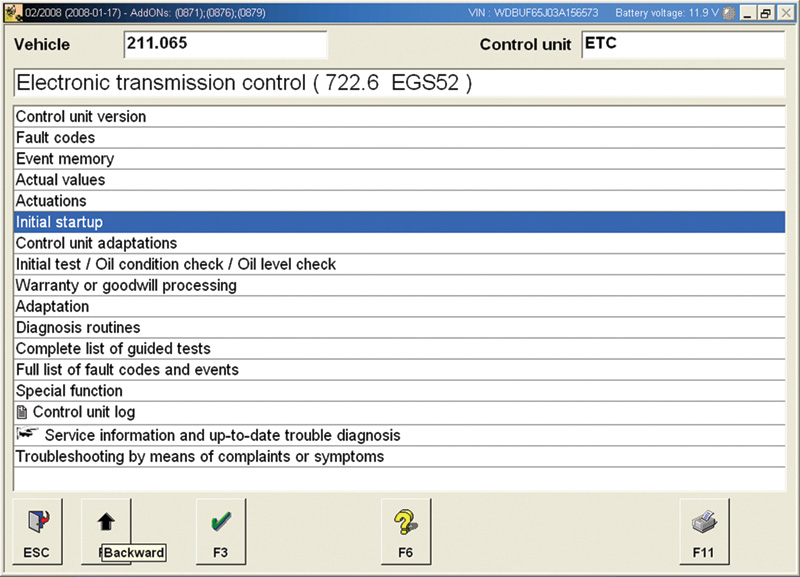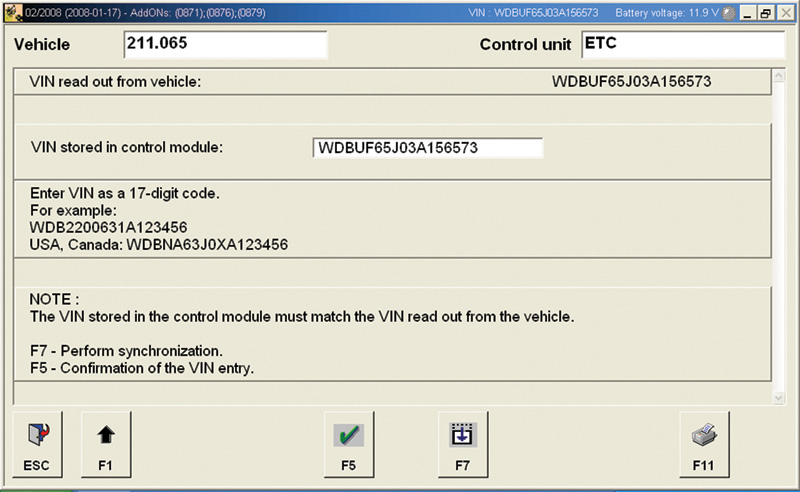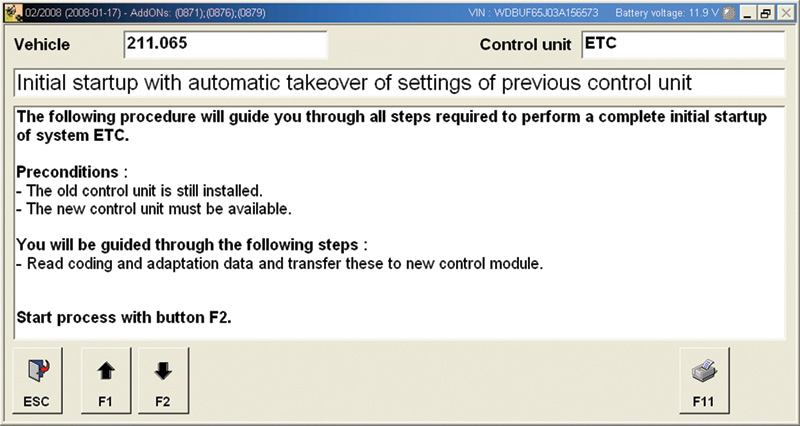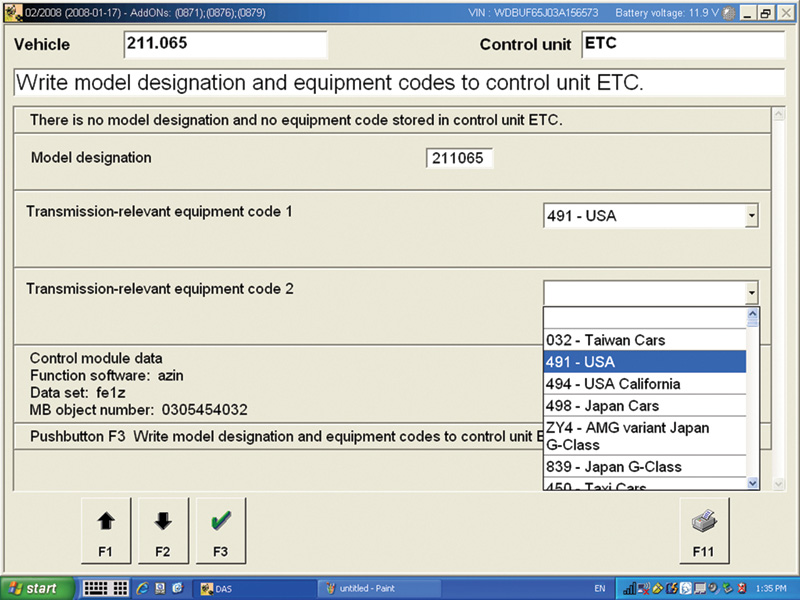Installing a new control unit to replace the failed one is only half the job. With various combinations of options available on the same model, the new unit has to learn which are installed and how to work with them.

With the old control unit still in the vehicle and an approved programming charger attached to the battery, plug in the Compact II, enter the unit you want to code, then select “Initial Startup.â€
Computer systems are everywhere these days. We have separate control modules strategically placed all over the vehicle. There is good reason for this. Excessive wiring can increase the weight of a vehicle, make assembly difficult and render diagnostics complicated. If wiring can be reduced, the problems associated with these three concerns diminish. By placing modules closest to the hardware components they control, wiring can be minimized.
As with any other technological advances, there is a teething period. A technician’s ability to diagnose a problem needs to play catch-up with this progress. Properly servicing computer-controlled systems is as important as diagnosis — once you know what’s wrong, you must be able to fix it. If the repair involves the replacement of a control unit, there are a few necessary steps needed to complete the job.
In Concert

You should see this screen indicating the vehicle’s VIN. Hit the synchronize button to retrieve the VIN, then confirm that the number is correct.
Very often, a control unit works in concert with several other control units because they are all on a CAN (Controller Area Network). Together, they provide a system of controls for the vehicle. Aside from computer controls of the systems they are dedicated to, they can share inputs and request output control. For example, there is no need to have a separate air temperature sensor for engine management if you can share information with the one that is dedicated to automatic climate control. The ambient air temperature sensor is one of the inputs used to calculate the need for air conditioning or heating. That control unit can be designed to put its temperature reading on the CAN where others can take it off.
Today, more of this cooperation is needed than ever before. If a control unit is changed, it must learn what others are on the CAN so it can send and receive the necessary information. This is accomplished through coding a control unit. When a new replacement is installed, the original coding information from the old unit must be installed. Up to now, coding was achieved with the SDS, but soon coding will be available using a J2534 Pass-Thru device. With the SDS, you need to remove coding information from the original control unit, then install the new “non-coded†model, and, finally, put this information on the new unit. Sounds simple enough, but there is a specific procedure that must be followed.
Flash!
If a problem in the software of a control unit is detected through warranty claims or other means, Mercedes-Benz will generate an updated program to repair the trouble. This is particularly important with ME (Motor Electronics) and ETC (Electronic Transmission Control) as emissions and shifting concerns need to be addressed (fuel formulas and driving styles can change). To be able to make these changes without providing an entirely new ECU requires something called “Flashing.†This is done by means of the SDS updating the software in the existing control unit. No physical parts need to be replaced. This is advantageous for everyone involved since a control unit often has multiple roles that would also have to be initialized in order for them to function properly. If you needed to replace instead of re-flash an ME control unit, you would also have to relearn the anti-theft system between the EIS (Electronic Ignition Switch) and the ME control unit. By only re-flashing the software you eliminate the need to align the anti-theft information with the ME unit.

At this point, you need to have the old control unit still plugged in. Selecting “Initial startup of a new control unit†will lead you to this screen. Follow the directions and the existing coding will be read from the old unit.
More On Control Unit Identity
These software changes have specific tasks to either correct or improve the drivability of a Mercedes-Benz. In the case of the ME or ETC, these programs have a specific effect on the overall emissions produced by the vehicle. They are therefore monitored by keeping track of software calibrations and giving them a specific identity. This is accomplished with the use of an SCN (Software Calibration Number). If it effects emissions, the EPA must be aware of these changes in software and approve them. Since each control unit has a SCN, you can find out the level of software in the vehicle, and determine if a newer release is available, or if the latest software is already installed.

If you have lost communication with the old control unit, you can write model designation and equipment codes yourself. Here, the country code is being selected. You may be asked questions on the options the vehicle has. If you don’t know all the answers, these options will not function.
Since 2003, SCN coding has been required by federal law. The SCN indicates if any tampering has occurred within the software of the control unit. Aftermarket companies that offer performance modifications usually do not meet the approval of the EPA, and are considered for off-road use only, such as racing. These performance “chips†or re-flashes, are illegal by state and federal standards and should not be used in cars driven on public roads. These control units will not have the necessary SCN to match the rest of the vehicle. Other control units will see the differences in the SCN and flag diagnostic trouble codes for it. This will turn on warning lights on the dash indicating that there is a problem. By the same token, if either an ME or ETC control unit is replaced and the SCN is not updated to match the vehicle, this is considered tampering even if no performance modifications are performed. This means with each new re-flash, the SCN needs to be updated as well. Are You Ready?
Worldwide Anti-Theft Policy Now in EffectA new worldwide Mercedes-Benz anti-theft policy went into effect at Mercedes-Benz USA on November 10, 2008. This policy has specific requirements for the ordering and delivery of Theft-Relevant Parts (TRPs), which may require you to get information from the vehicle owner to place an order for certain spare parts. In addition, for certain theft-relevant parts, such as electronic keys, electronic ignition switches, infrared and other locking control units, it is mandatory for the dealer to install them. Please contact your local dealer for a copy of the policy so you can be better prepared to help them protect all Mercedes-Benz vehicles from theft. |
When replacing a control unit, you need to code it to the vehicle. This is achieved using your Compact III or Basic. Before starting any coding or programming, you must have an approved battery charger connected to the vehicle to keep voltage steady during the procedure. Aftermarket companies make programming battery chargers available that are capable of reacting to sudden voltage drops caused by the control units switching on various components. Traditional battery chargers react too slowly for this purpose, so you must make the investment.
You have two options when coding. You can either download the old control unit’s existing software while it is still installed in the vehicle, plug in the new unit and then upload the old software into the new unit. If you have totally lost communication with the old unit, you can install the new one and “write†model and coding information yourself. This second option is difficult since you need to be familiar with all of the options installed on the vehicle, as well as those that are not.
Using SDS, select the control unit you would like to replace. While under that heading, select “Initial Startup.†You will be directed to a screen showing no VIN in the new control unit. After synchronizing with the other units, you should read the vehicle VIN and confirm the entry. Next, select “Initial Startup of a new control unit,†and the next screen will guide you through the process of replacement. The first step is to read the existing coding information. After this is complete, turn off the ignition key and replace the control unit. Turn the key back on, select the F2 key to upload the software and you are almost done. You should go into “Quick Tests†and scan, then clear, all codes in each control unit. Road test the vehicle and verify that all functions are working properly.
In the case of the ME control unit, make sure functions such as cruise control are working. If coded successfully, you should have no problems and/or warning lights on in the dash. This is now a completed repair and you can give the vehicle back to the customer with the confidence that comes from knowing the job was done right. This should give everyone involved peace of mind.






0 Comments